To be honest, most people have long associated salad recipes with more ostentatious and decadent dishes. a supporting performance. A footnote. Something you “must” consume. But what if we reversed the order?
That’s what this guide is here to do.
You’ve come to the right place whether you’re looking for a colourful summer salad for a potluck, a protein-rich chicken salad for supper, or a way to make kale taste less like punishment. This isn’t just another list; it includes everything from the hearty layers of a traditional potato salad to internationally inspired dishes like our Gyro salad. It is a dynamic, dynamic salad playbook.
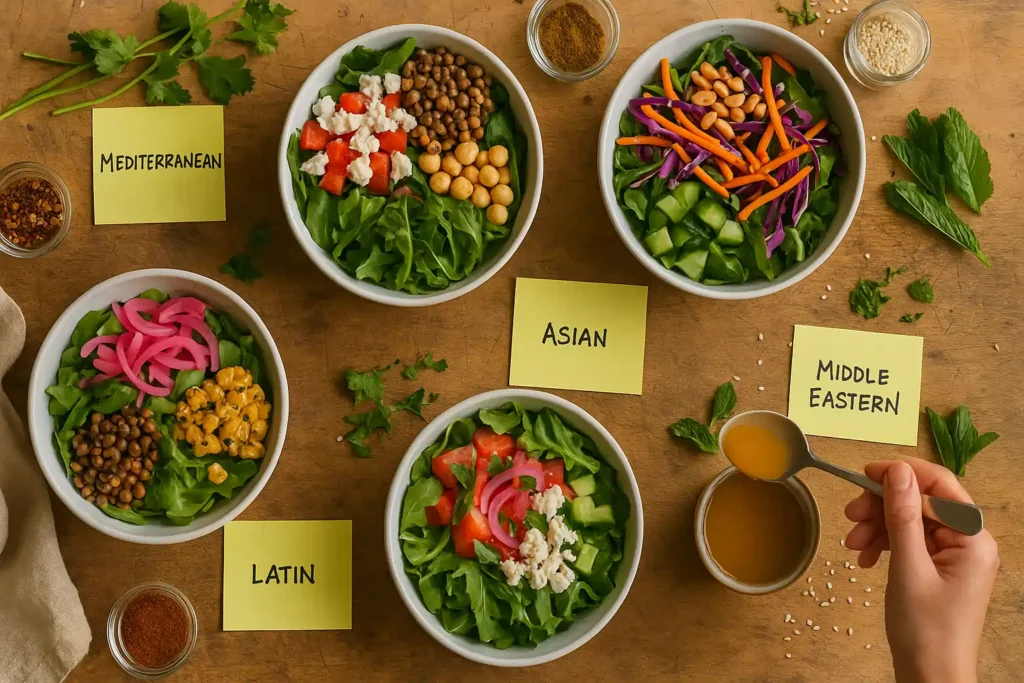
Table of Contents
Table of Contents
Why Salads Are More Than Just a Side Dish
In the world of food, there is a subliminal bias that salads are somehow “less than.” Less flavorful, less satisfying, and less deserving of attention. But you know better if you’ve ever eaten a plate of arugula with balsamic glaze on top of a steak or tucked into a cold bowl of zesty Mediterranean chickpea salad. Salads aren’t just for sides. They make a declaration. One of the most nostalgic and surprisingly bold examples? Miracle Salad—a creamy, tangy genre of salads that’s making a viral comeback.
Salads are incredibly versatile and profoundly personal at their best. They are seasonal, with farro and roasted squash in the fall and fresh peaches and basil in the summer. Whether you’re trying to meal-prep your week into submission, feeding picky kids, or following a ketogenic diet, they adjust to your lifestyle. They also travel well and tend to get better over time, which is more than most takeout can say.
Additionally, salads act as culinary mirrors. Are you curious about a culture’s values? Take a look at its salads. These foods, which range from spicy Thai papaya salad to finely chopped Middle Eastern tabbouleh, have the texture, temperature, and seasoning profiles that characterise entire cuisines. Additionally, they frequently require little cooking, which is a huge plus, let’s face it.
Therefore, it might be time to change your perspective if you’ve been considering salads as a stopover before moving on to something “more filling.” Every sense is satisfied by a well-constructed salad: crunch, cream, spice, acid, warmth, and chill. That’s not energy from a side dish. That is the power of the centre plate.
The Anatomy of a Perfect Salad
Every great salad has a story to tell about contrast, balance, and the little things that give a bite its fullness. However, this is not how most of us think about salads. After throwing some greens in a bowl and drizzling them with bottled dressing, we’re done. And that’s all well and good until you try a salad that works. One that causes you to stop. It dawns on you then that there is a method to this madness.
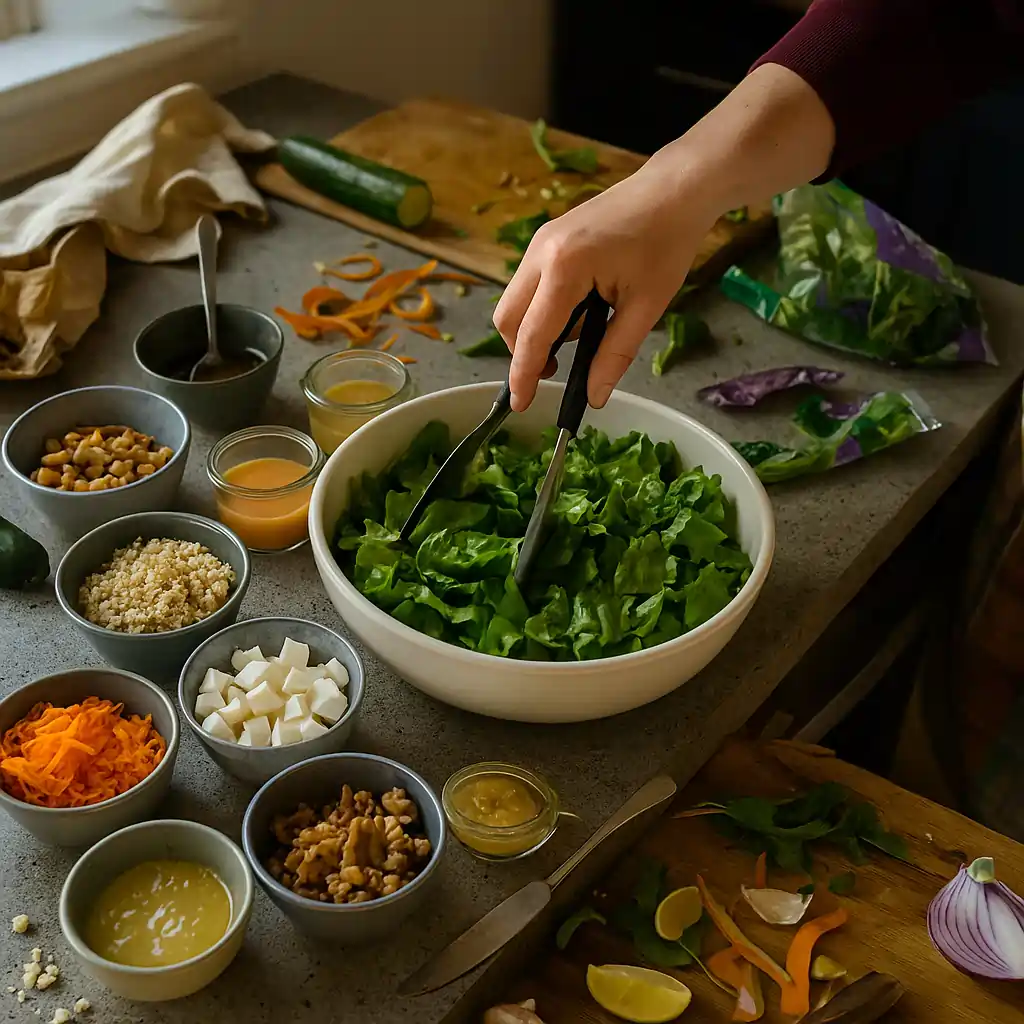
Let’s dissect it as a toolkit rather than a formula. Consider them as building blocks that you can combine and try different combinations until you find what works.
Choosing Your Greens: A Flavor Guide
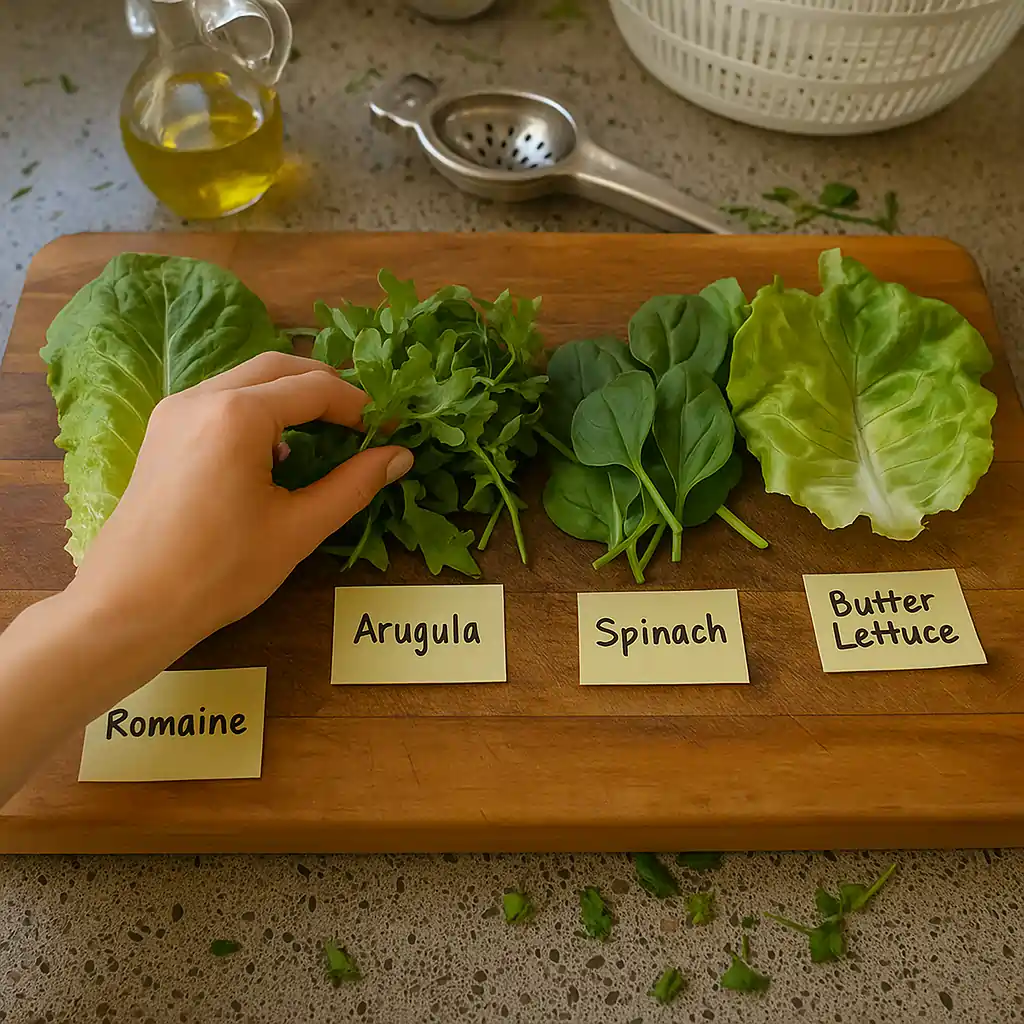
Greens aren’t just filler — they set the stage. Crisp romaine offers snap and structure. Peppery aGreens set the scene and are more than just filler. Crisp romaine provides structure and snap. Arugula with pepper gives it a bite. On the tongue, butter lettuce melts. Every green has a purpose, and salads become enticing when you learn to combine them with the appropriate toppings.
- Romaine is excellent for robust dressings like Caesar and crunchy bases.
- Spicy arugula pairs well with tart cheeses or sweet fruits.
- Spinach is versatile, mild, and perfect for warm toppings.
The secret is contrast and texture; for depth, combine at least two kinds.
Protein Power: Meat, Fish, and Plant-Based Options
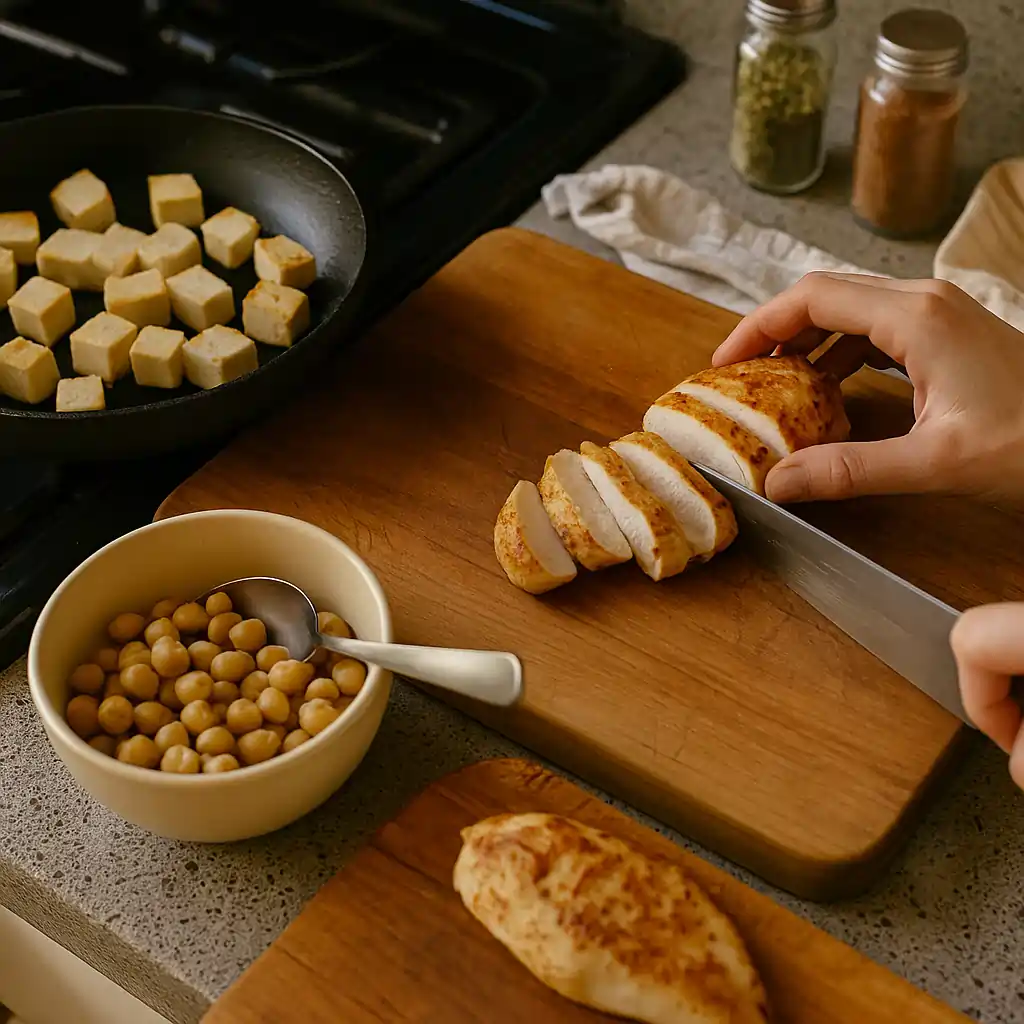
What transforms a salad from a snack into a meal is protein. However, in the world of salads, not all proteins are made equal.
- Grilled chicken or steak: classic, hearty, neutral canvas
- Salmon or tuna: bold flavor, rich texture
- Chickpeas, tofu, tempeh: great for vegetarians, soak up dressings well
- Boiled eggs or cheese: dense protein + creamy contrast
The key is balance. Consider the flavour and texture of each protein’s interactions with the greens and dressing.
Toppings that Delight: From Crunchy to Creamy
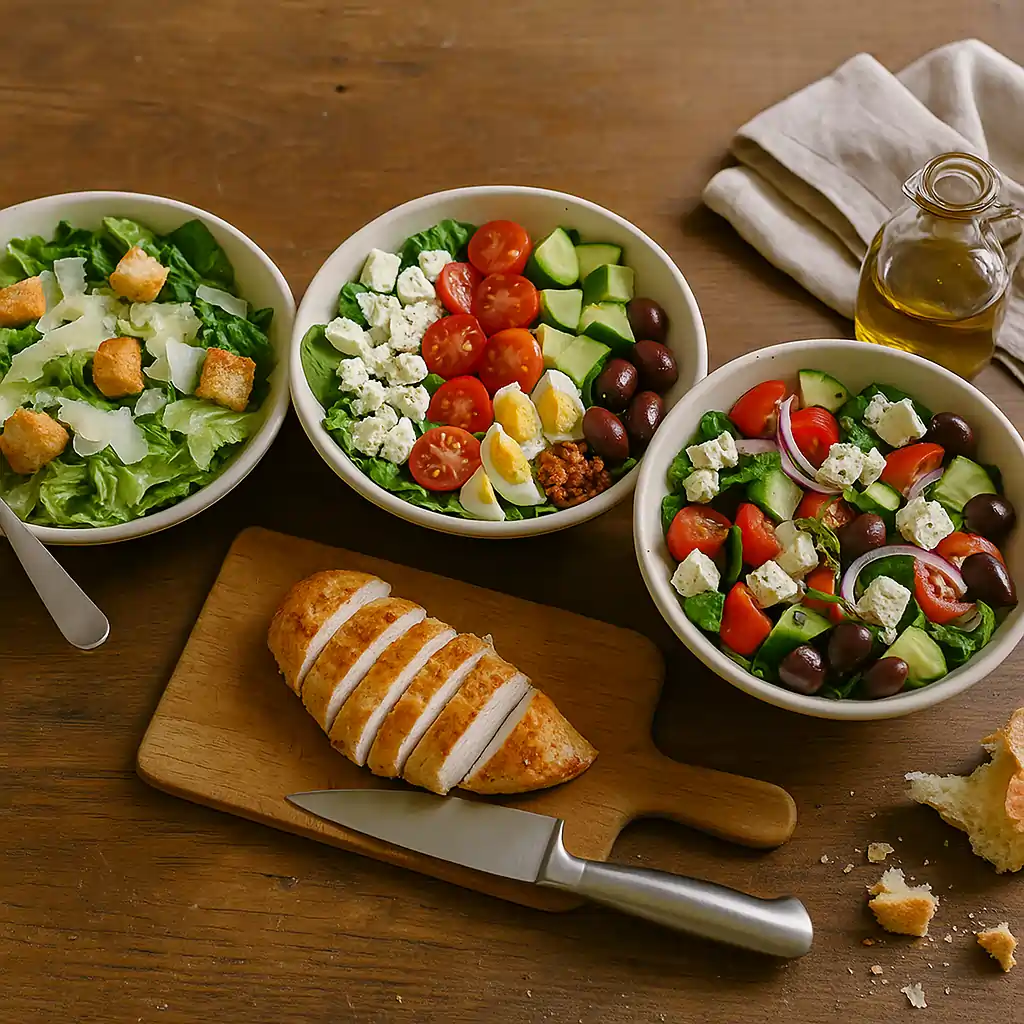
Most homemade salads fail at this point. Layers of texture, including crispy, chewy, creamy, and fresh, make up a genuinely satisfying salad.
- Crunchy: toasted nuts, croutons, crispy onions, seeds
- Chewy: dried fruit, roasted grains, cooked lentils
- Creamy: avocado, goat cheese, hummus dollops
- Fresh: cucumbers, radishes, shredded carrots
For a mouthfeel combination that adds interest to each bite, choose one from each category.
Dress for Success: The Perfect Salad Dressing
If the dressing doesn’t keep the salad together, even the best ingredients can result in a dull salad. A well-chosen dressing enhances rather than overpowers.
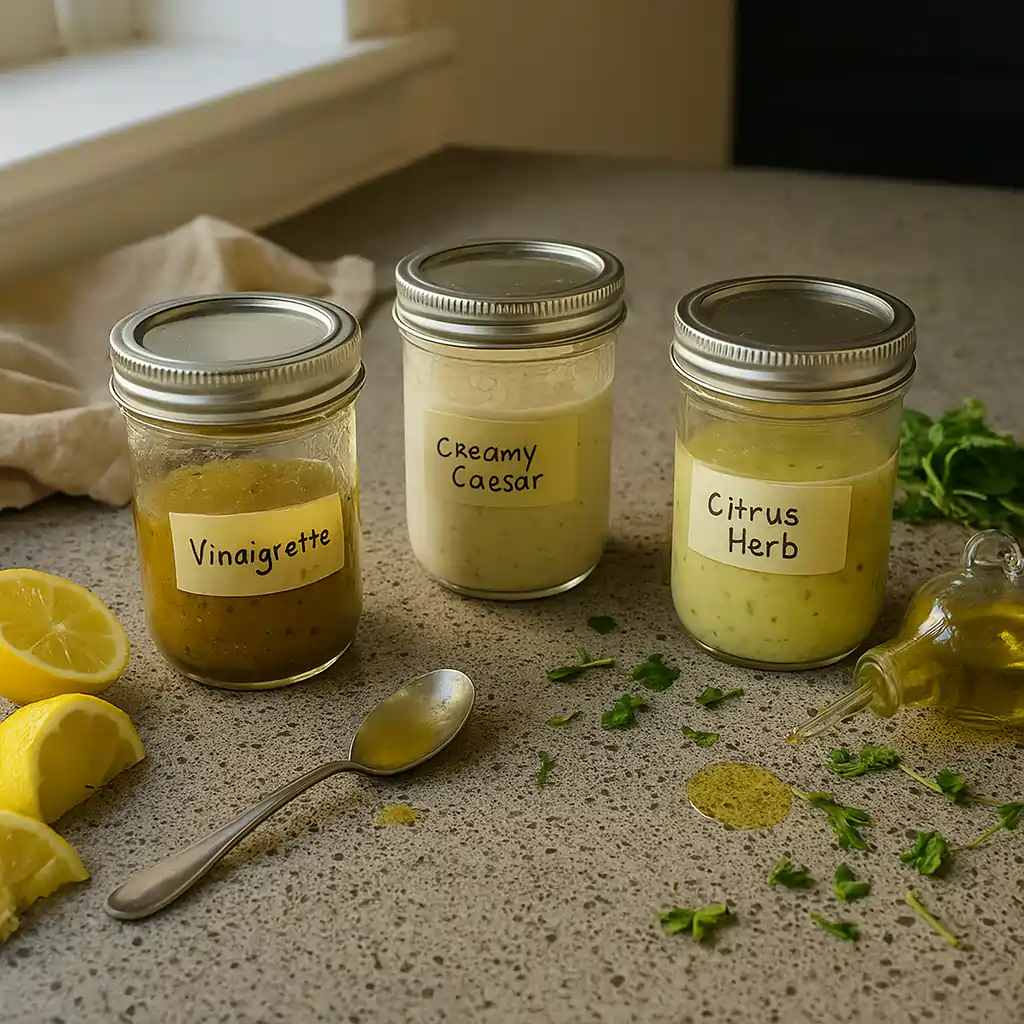
- Vinaigrettes: light, tangy, good with bitter greens or fruit
- Creamy dressings: ranch, Caesar, blue cheese — best with crunchy bases
- Citrus-based: bright, refreshing, great for warm-weather salads
- Yogurt/herb-based: cool, herby, ideal with Mediterranean or grain salads
In addition to tasting infinitely better, homemade dressings only take five minutes to prepare and allow you to control the amount of sugar, salt, and oil.
Our Top 10 Most Popular Salad Recipes of All Time
Why is a particular salad recipe a recurring favourite? Reliability, crave-worthiness, and that “just one more bite” factor are more important than flavour alone. Whether they’re trying to improve Tuesday lunch, feed a crowd, or prepare meals for the week, these are the recipes that our readers keep coming back to.
You can either bookmark this list and go through it in order, or you can click on the links below to go directly to the recipe that appeals to you.
The Top 10 List:
- Watermelon Feta Mint Salad: The Ultimate Summer Bowl
- The Best Creamy Whitefish Salad Recipe
- Ribbon Salad Recipes: The Viral Trend You’ll Actually Want to Eat
- The Ultimate Blue Cheese Salad Recipe
- Easy and Delicious Gyro Salad Recipe
- Snappy Salad Bam Bam Salad Copycat Recipe
- Easy Fiesta Salad Recipe with Creamy Cilantro Dressing
- The Best Southwest Chicken Salad Recipe
- The Ultimate Ranch Salad Recipe
- Can You Freeze Tuna Salad? The Definitive Guide
Classic Salad Recipes Everyone Should Know
There’s a reason why some salads have endured over time. Because everyone enjoys them, these are the staple dishes that are served at potlucks, on bistro menus, and at family picnics. However, even classics can be made better. These tried-and-true recipes become unforgettable with a few adjustments and the proper proportions of ingredients.
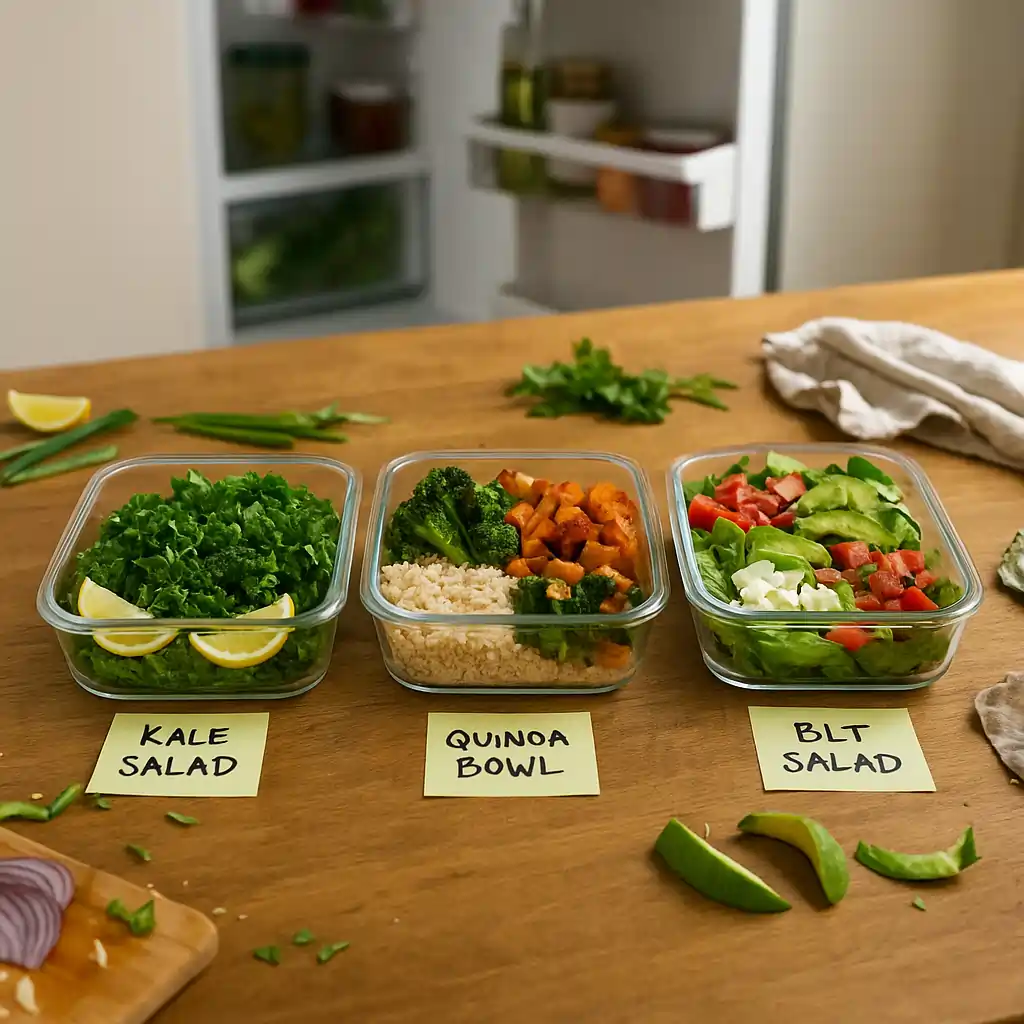
The Perfect Caesar Salad
A good Caesar is more than just romaine and croutons drenched in dressing; it’s a thoughtfully constructed dish that delivers a punch of salt, cream, and tang with each bite. Make your own dressing (trust us on this), start with crisp hearts of romaine, and shave in real Parmigiano-Reggiano. Sceptics of anchovies? Mix it with the dressing. The depth won’t taste like fish.
Serve it with crusty garlic bread, grilled chicken, or a soft-boiled egg.
A Classic Cobb Salad
The Cobb, a chopped salad that strikes a balance between crunch and richness, was first mixed together at midnight in a Hollywood restaurant and is the epitome of American comfort. Imagine: cleanly arranged or tossed (based on your tolerance for chaos) avocado, blue cheese, bacon, hard-boiled eggs, chicken, tomatoes, and romaine.
It is rich in colour, palatable, and incredibly fulfilling. It all comes together without being overpowered by the homemade red wine vinaigrette.
The Greek Salad, Done Right
Simplicity can be beautiful. Instead of using lettuce, the Greek salad, also known as horiatiki, emphasises tomatoes, cucumbers, red onions, kalamata olives, and large chunks of feta. Balance between salty, acidic, crisp, and creamy flavours is crucial. Don’t cut corners on the oregano and use high-quality olive oil.
It can be made into a full meal with additions like grilled chicken or chickpeas, but it also tastes great by itself with pita or grilled meats.
Healthy Salad Recipes for a Nutrient-Packed Meal
Let’s face it: “healthy” salads aren’t always seen favourably. It’s too dry. It’s too light. Too tasteless. However, when executed properly, they are not any of those things. A well-constructed, nutritious salad is colourful, substantial, and layered with different textures to add interest to each bite. These recipes show that you don’t have to give up flavour to feel good about your food, whether you’re following a macro-tracking regimen, eating clean, or simply trying to fit more vegetables into your day.
Quinoa Salads for a Protein Boost
Quinoa is more than just a trendy grain; it’s a complete protein that tastes great in cold salads. Its nutty flavour goes well with plant-based proteins like black beans or chickpeas, citrous vinaigrettes, and roasted vegetables. Add some chopped herbs and some toasted nuts for crunch, and you have a week’s worth of power bowls.
For added visual appeal, use tricolour quinoa. For a deeper flavour, cook it in broth rather than water.
Kale Salads with Lemon-Vinaigrette
Kale has a bad reputation, and if you skip the preparation, it really does deserve it. However, when prepared properly, kale salads can be vibrant, juicy, and even compulsive. The key? Using a little salt and olive oil, massage the leaves until they become softer and darker. Add shredded carrots, cranberries, lemon vinaigrette, and a sharp cheese, such as pecorino, and toss.
It’s perfect for meal-prep lunches or potlucks because it’s durable enough to last overnight.
Low-Carb Salads for a Keto Diet
Reducing carbohydrates does not equate to reducing satisfaction. A BLT salad with ranch and cherry tomatoes, or grilled chicken over spinach with avocado and bacon, are examples of low-carb salads that emphasise fats, protein, and fibre. As bases, you can also use sliced mushrooms, roasted zucchini, or cauliflower rice.
You can maintain a high level of flavour without increasing your carbohydrate intake by sticking to oil-based dressings, such as Caesar or lemon garlic.
Salad Recipes from Around the World
Once you start experimenting, it’s difficult to return to the same old garden mix because every culture has its own unique twist on the simple salad. Simple bowls become culinary passports thanks to the addition of bold spices, unusual textures, and regional ingredients in these internationally inspired dishes. These recipes offer a novel way to experience the world, one bite at a time, whether you’re looking for something spicy and umami-packed or bright and herbaceous.
Mediterranean Salads
With its abundance of sun-drenched ingredients, straightforward seasonings, and copious amounts of olive oil, the Mediterranean region is a salad powerhouse. Consider lentil and feta bowls, roasted eggplant with tahini, or chopped cucumber-tomato-parsley mixtures (similar to Israeli salads).
Here, a little lemon juice and some fresh herbs really help. These salads can be served with grilled meats and seafood or scooped with pita because they frequently double as mezze.
Asian-Inspired Salads
Asian salads aren’t just leafy; they’re also crunchy, spicy, and frequently served warm or at room temperature. There are noodle-based dishes stuffed with peanuts and fresh herbs, Thai papaya salads with lime and chilli, and slaws made with rice vinegar and sesame oil.
Sweet, sour, salty, and spicy all need to be in balance. To add layers of flavour, use ingredients like ginger, cilantro, soy sauce, fish sauce, and crushed peanuts.
Latin American Salads
Freshness and heat are frequently celebrated in Latin American salads. The flavours range from Mexican jicama slaws to lime-drenched bean salads to Peruvian corn and avocado salads.
Common ingredients include pickled onions, lime juice, cilantro, and hot peppers like poblanos or jalapeños. While many of these dishes can be served as side salads with rice bowls, tacos, or grilled meats, some, like sweet potato and black bean salad, are also great on their own.
Frequently Asked Questions About Salads
Head-scratchers are encountered by even the most experienced salad makers. I’ve compiled the most frequently asked salad questions and provided straightforward, no-nonsense answers, whether you’re wondering how to prevent greens from wilting or whether pasta salad qualifies as a “real” salad (spoiler alert: it does).
What makes a salad “healthy”?
A healthy salad usually includes a mix of fiber-rich vegetables, a quality protein source, healthy fats (like olive oil or avocado), and minimal added sugars or processed ingredients. Watch the dressing — that’s often where excess calories or sodium sneak in.
Can salads really be a full meal?
Absolutely. Add protein (chicken, tofu, beans), fiber (grains, legumes), healthy fats (avocado, nuts), and complex carbs if needed. A hearty salad can be more balanced than many traditional dinners — and just as satisfying.
How do you store salad without it wilting?
Keep greens dry and store them in a sealed container with a paper towel to absorb moisture. Dress right before serving. For meal-prep, layer sturdy ingredients on the bottom and keep dressing in a separate container until ready to eat.
What’s the best salad dressing for weight loss?
Vinegar-based dressings (like balsamic or lemon vinaigrette) are usually lower in calories than creamy options. You can also make your own with olive oil, mustard, and citrus to control sugar and salt levels.
How do I make a salad more interesting?
Mix up textures and flavors. Add roasted veggies, pickled items, fresh herbs, or seasonal fruits. Switch your greens. Try a new dressing. The key is contrast — creamy + crunchy, sweet + salty, warm + cool.
Your Salad Game, Upgraded
As you’ve seen by now, salads are anything but dull. They are adaptable, rich in culture, and have the potential to be the most fulfilling item on your plate rather than just the accompaniment. You now have the recipe to make it correctly, whether you’re creating a traditional Caesar, experimenting with quinoa and roasted vegetables, or trying a zesty salad from across the world.
This guide was not intended to be read once and then put away. Save it to your bookmarks. When you’re bored with salads or simply want something dependable, fresh, and quick, come back.
